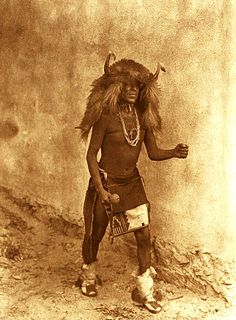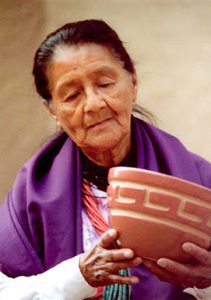Related Research Articles
The Puebloans or Pueblo peoples, are Native Americans in the Southwestern United States who share common agricultural, material, and religious practices. Pueblo, which means "village" in Spanish, was a term originating with the Colonial Spanish, who used it to refer to the people's particular style of dwelling.

Kewa Pueblo, formerly known as Santo Domingo Pueblo, is a census-designated place (CDP) in Sandoval County, New Mexico, and a federally-recognized tribe of Native American Pueblo people.

The Zia or Tsʾíiyʾamʾé are an indigenous tribe centered at Zia Pueblo (Tsi'ya), an Indian reservation in the U.S. state of New Mexico. The Zia are known for their pottery and use of the sun symbol. They are one of the Keres Pueblo peoples and speak the Eastern Keres language.

Maria Montoya Martinez was a Native American artist who created internationally known pottery. Martinez, her husband Julian, and other family members examined traditional Pueblo pottery styles and techniques to create pieces which reflect the Pueblo people's legacy of fine artwork and crafts. The works of Maria Martinez, and especially her black ware pottery, survive in many museums, including the Smithsonian, the Metropolitan Museum of Art, the Denver Art Museum, and more. The Penn Museum in Philadelphia holds eight vessels – three plates and five jars – signed either "Marie" or "Marie & Julian". Maria Martinez was from the San Ildefonso Pueblo, a community located 20 miles northwest of Santa Fe, New Mexico. At an early age, she learned pottery skills from her aunt and recalls this "learning by seeing" starting at age eleven, as she watched her aunt, grandmother, and father's cousin work on their pottery during the 1890s. During this time, Spanish tinware and Anglo enamelware had become readily available in the Southwest, making the creation of traditional cooking and serving pots less necessary. Traditional pottery making techniques were being lost, but Martinez and her family experimented with different techniques and helped preserve the cultural art.

Ohkay Owingeh is a census-designated place (CDP) in Rio Arriba County, New Mexico, United States and a federally recognized tribe of Native American Pueblo people. As of 2017 1480 people were estimated to be living in the CDP, with 6,690 in the surrounding Census County Division. The 2010 census found that 1,522 people in the U.S. described themselves as exclusively Ohkay Owingeh and 1,770 as Ohkay Owingeh exclusively or in combination with another group.

Lucy Martin Lewis was a Native American potter from Acoma Pueblo, New Mexico. She is known for her black-on-white decorative ceramics made using traditional techniques.

Maria Margarita "Margaret" Tafoya was the matriarch of Santa Clara Pueblo potters. She was a recipient of a 1984 National Heritage Fellowship awarded by the National Endowment for the Arts, which is the United States government's highest honor in the folk and traditional arts.
Arthur and Hilda Coriz were Native American husband and wife potters from Santo Domingo Pueblo, New Mexico, United States.
Anthony Durand (1956–2009) was a Native American potter from Picuris Pueblo, New Mexico, United States. He was born in Cortez, Colorado and raised by his grandparents at Picuris Pueblo. He attended primary and secondary school in Peñasco, New Mexico and college at New Mexico Highlands University. When he returned to Picuris in 1976, he became intent on preventing the Picuris micaceous tradition of pottery from dying out. He had an excellent teacher in his grandmother Cora Durand. In 1976, Cora and Francis Martinez were the only ones making traditional Picuris-style pottery. With inspiration from his grandmother, Anthony was producing pottery on a full-time basis within a year.
Nathan Youngblood is a Native American potter from Santa Clara Pueblo, New Mexico, United States.

The Pueblo Revival style or Santa Fe style is a regional architectural style of the Southwestern United States, which draws its inspiration from traditional Pueblo architecture and the Spanish missions in New Mexico. The style developed at the beginning of the 20th century and reached its greatest popularity in the 1920s and 1930s, though it is still commonly used for new buildings. Pueblo style architecture is most prevalent in the state of New Mexico.

Julián Martínez, also known as Pocano (1879–1943), was a San Ildefonso Pueblo potter, painter, and the patriarch of a family of Native American ceramic artists in the United States.

Michael Kanteena is an award-winning potter from Laguna Pueblo, New Mexico. He is best known for his pottery inspired by Chaco, Mesa Verde and other Ancestral Pueblo pottery. Kanteena also makes pottery inspired by historic kachina dolls and kachina masks. His work has been displayed in the Maxwell Museum in Albuquerque, the Wheelwright Museum in Santa Fe, and at many commercial galleries. Kanteena also shows his work at the annual Santa Fe Indian Market.
Tammy Garcia is a Santa Clara Pueblo sculptor and Ceramic artist. Garcia translates Pueblo pottery forms and iconography into sculptures in bronze and other media.

Paul Joseph "Speckled Rock" Tafoya was a Native American artist who was noted for his paintings, bear fetishes, bronze sculptures of Native American dancers, and redware and blackware pottery. A member of the Tewa and a resident of the Santa Clara Pueblo in New Mexico, Paul was the owner of the Merrock Galeria, which featured the work of contemporary pueblo artists.

Angela Tafoya Baca was a Native American artist who was known for her redware and blackware pottery, especially melon bowls and bowls featuring a bear paw design. She had one of the longest careers of the potters in Santa Clara Pueblo in New Mexico. She was a member of the Tewa and a resident of Santa Clara Pueblo.
Christine McHorse, also known in the art world as Christine Nofchissey McHorse, is a ceramics artist of Navajo descent. Her work combines Navajo and Pueblo art traditions.
Maria Ramita Simbolo Martinez"Summer Harvest" was a Picuris Pueblo potter. Martinez learned traditional methods of creating pottery and has been recognized for preserving a cultural tradition of the Picuris Pueblo. Martinez collaborated with her husband, Juan José Martinez, who decorated her finished pots.
Juanita Inez Ortiz, also known as Inez Ortiz was a Native American Cochiti Pueblo artist, specializing in pottery. She is of the Herrera family of Pueblo potters in New Mexico, whose work is often found in art collections and in art museums. She was from the Cochiti Pueblo in Cochiti, New Mexico.

Pueblo pottery are ceramic objects made by the indigenous Pueblo people and their antecedents, the Ancestral Puebloans and Mogollon cultures in the Southwestern United States and Northern Mexico for almost two thousand years. Most Southwestern native peoples developed a pottery tradition, however the Pueblo peoples excelled in form, size, and ornamention. The modern and contemporary Tewa people of Kha'po Owingeh and P'ohwhóge Owingeh favored working in blackware, whereas the Keresan-speaking people of Acoma Pueblo and the Shiwiʼma speaking people of the Pueblo of Zuni work with a wide variety of colors and design motifs.
References
- Hoard, Dorothy (1983). A Guide to Bandelier National Monument. Los Alamos Historical Society. ISBN 0-941232-04-2.